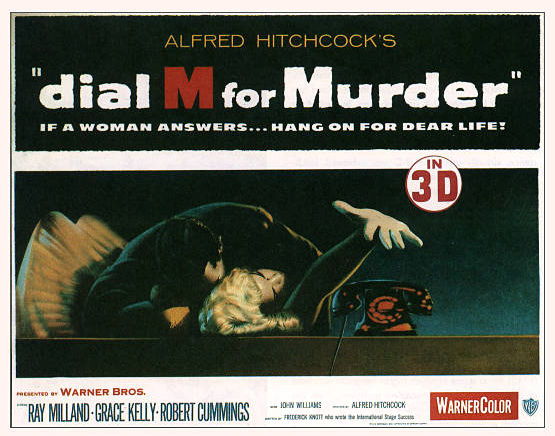
Writers: Frederick Knott (also play)
Composer: Dmitri Tiomkin
Director of Photography: Robert Burks
Cast:
George Alderson..................First Detective
Patrick Allen....................Pearson
Leo Britt........................The Storyteller
Sanders Clark....................Detective
Robert Cummings..................Mark Halliday
Anthony Dawson...................Captain Lesgate
Robert Dobson....................Police Photographer
Guy Doleman......................Detective
Sam Harris.......................Man in Phone Booth
Robin Hughes.....................Police Sergeant
Grace Kelly......................Margot Wendice
George Leigh.....................Williams
Ray Milland......................Tony Wendice
Thayer Roberts...................Detective
John (I) Williams................Inspector Hubbard
Frederick Knott's thriller Dial "M" For Murder was a great success in London and New York in 1952, and because he had abandoned another project, Hitchcock decided to film this play in fulfillment of his contractual obligations. The task was accomplished in little more than a month: the single set made production simple, and there was little to do with the text except tighten and focus a ready-made script. Warner Bros. required him to shoot the picture in the fad of the day -- 3-D, one of the industry's tricks to woo audiences away from the postwar television boom. Perhaps suspecting that this was a passing fancy, Hitchcock elected not to exploit the usual pranks of three-dimensional filmmaking, and so there are no knives or fists hurled at the audience, nor does anyone fall from a great height onto our laps.
The story concerns a retired tennis champion, Tony Wendice. Anxious to inherit the fortune of his wife Margot and resentful of her attentions to the dull young novelist Mark Halliday, he ingeniously plans her murder. Arranging what appears to be the perfect crime, Tony blackmails a man named Lesgate, a former classmate with a criminal record, into committing the deed. But the plans are foiled when Margot resists her attacker, reaches for a pair of scissors, and stabs him to death. Undaunted, Tony now decides to take his scheme in a different direction, trying to convince canny Inspector Hubbard that his wife killed Lesgate because he was blackmailing her. The inspector, however, begins to reason otherwise, and with the help of Margot and Mark a situation is arranged which reveals Tony as the villain.
Back to Pete's Pad |
Movies Page |
Hitchcock
Text copyright © Donald Spoto, The Art of Alfred Hitchcock, 1974
